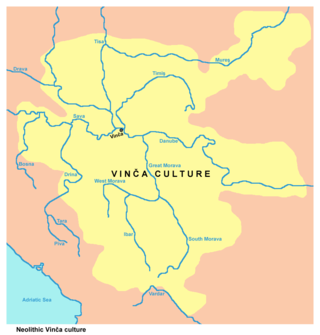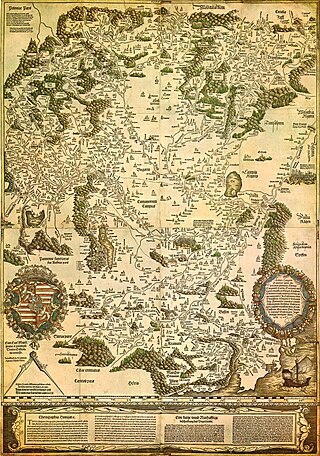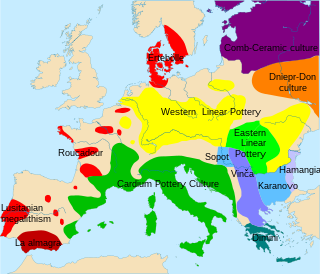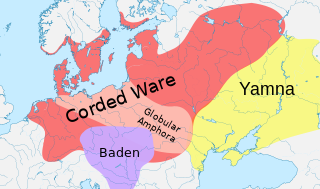Artefacts
- Anthropomorphic pottery
- Ceramic altar, 5300-5200 BC. [3]
- Tisza pottery
- Modern sculpture depicting the Szegvár-Tűzkövesi idol
| Horizon | Old Europe |
|---|---|
| Geographical range | Central Europe, Pannonian Plain |
| Period | Neolithic, Chalcolithic |
| Dates | c. 5400 BC – 4500 BC |
| Preceded by | Linear Pottery culture, Starčevo culture |
| Followed by | Tiszapolgár culture, Lengyel culture |
The Tisza culture is a Neolithic archaeological culture of the Alföld plain in modern-day Hungary, Western Romania, Eastern Slovakia, and Ukrainian Zakarpattia Oblast in Central Europe. The culture is dated to between 5400 BCE and 4500/4400 BCE. [1] [2]
Lipson et al. (2017) analyzed the remains of five individuals ascribed to the Tisza culture. The three males were G-P15, I-P37 and I-P215. [6] mtDNA extracted were various subclades of U, H, T, and K. [6]

The Neolithic or New Stone Age is an archaeological period, the final division of the Stone Age in Europe, Asia and Africa. It saw the Neolithic Revolution, a wide-ranging set of developments that appear to have arisen independently in several parts of the world. This "Neolithic package" included the introduction of farming, domestication of animals, and change from a hunter-gatherer lifestyle to one of settlement. The term 'Neolithic' was coined by Sir John Lubbock in 1865 as a refinement of the three-age system.
The 6th millennium BC spanned the years 6000 BC to 5001 BC. It is impossible to precisely date events that happened around the time of this millennium and all dates mentioned here are estimates mostly based on geological and anthropological analysis. The only exceptions are the felling dates for some construction timbers from Neolithic wells in Central Europe.

The Vinča culture (ʋîːntʃa), also known as Turdaș culture, Turdaș–Vinča culture or Vinča-Turdaș culture, is a Neolithic archaeological culture of Southeast Europe, dated to the period 5400–4500 BC. Named for its type site, Vinča-Belo Brdo, a large tell settlement discovered by Serbian archaeologist Miloje Vasić in 1908, it represents the material remains of a prehistoric society mainly distinguished by its settlement pattern and ritual behaviour.

The Ubaid period is a prehistoric period of Mesopotamia. The name derives from Tell al-'Ubaid where the earliest large excavation of Ubaid period material was conducted initially in 1919 by Henry Hall and later by Leonard Woolley.

The European Neolithic is the period from the arrival of Neolithic technology and the associated population of Early European Farmers in Europe, c. 7000 BC until c. 2000–1700 BC. The Neolithic overlaps the Mesolithic and Bronze Age periods in Europe as cultural changes moved from the southeast to northwest at about 1 km/year – this is called the Neolithic Expansion.
Old Europe is a term coined by the Lithuanian archaeologist Marija Gimbutas to describe what she perceived as a relatively homogeneous pre-Indo-European Neolithic and Copper Age culture or civilisation in Southeast Europe, centred in the Lower Danube Valley. Old Europe is also referred to in some literature as the Danube civilisation.

The Starčevo culture is an archaeological culture of Southeastern Europe, dating to the Neolithic period between c. 6200 and 4500 BCE. It originates in the spread of the Neolithic package of peoples and technological innovations including farming and ceramics from Anatolia to the area of Sesklo. The Starčevo culture marks its spread to the inland Balkan peninsula as the Cardial ware culture did along the Adriatic coastline. It forms part of the wider Starčevo–Körös–Criş culture which gave rise to the central European Linear Pottery culture c. 700 years after the initial spread of Neolithic farmers towards the northern Balkans.

The Funnel(-neck-)beaker culture, in short TRB or TBK, was an archaeological culture in north-central Europe. It developed as a technological merger of local neolithic and mesolithic techno-complexes between the lower Elbe and middle Vistula rivers. These predecessors were the (Danubian) Lengyel-influenced Stroke-ornamented ware culture (STK) groups/Late Lengyel and Baden-Boleráz in the southeast, Rössen groups in the southwest and the Ertebølle-Ellerbek groups in the north. The TRB introduced farming and husbandry as major food sources to the pottery-using hunter-gatherers north of this line.

The history of Hungarybefore the Hungarian conquest spans the time period before the Hungarian conquest in the 9th century of the territories that would become the Principality of Hungary and the Kingdom of Hungary.
Sesklo is a village in Greece that is located near Volos, a city located within the municipality of Aisonia. The municipality is located within the regional unit of Magnesia that is located within the administrative region of Thessaly. During the prehistory of Southeastern Europe, Sesklo was a significant settlement of Neolithic Greece, before the advent of the Bronze Age and millennia before the Mycenaean period.

The Lengyel culture is an archaeological culture of the European Neolithic, centered on the Middle Danube in Central Europe. It flourished from 5000 to 4000 BC, ending with phase IV, e.g., in Bohemia represented by the 'Jordanow/Jordansmühler culture'. It is followed by the Funnelbeaker culture/TrB culture and the Baden culture. The eponymous type site is at Lengyel in Tolna county, Hungary.

The Hamangia culture is a Late Neolithic archaeological culture of Dobruja between the Danube and the Black Sea and Muntenia in the south. It is named after the site of Baia-Hamangia, discovered in 1952 along Golovița Lake.

Prehistoric Europe refers to Europe before the start of written records, beginning in the Lower Paleolithic. As history progresses, considerable regional unevenness in cultural development emerges and grows. The region of the eastern Mediterranean is, due to its geographic proximity, greatly influenced and inspired by the classical Middle Eastern civilizations, and adopts and develops the earliest systems of communal organization and writing. The Histories of Herodotus is the oldest known European text that seeks to systematically record traditions, public affairs and notable events.

The Baden culture or Baden-Pécel culture is a Chalcolithic archaeological culture dating to c. 3520–2690 BC. It is found in Central and Southeast Europe, and is in particular known from Moravia, Romania, Hungary, southern Poland, Slovakia, northern Croatia and eastern Austria. Imports of Baden pottery have also been found in Germany and Switzerland. It is often grouped together with the Coțofeni culture as part of the Baden-Coțofeni culture.

In the archaeology of Southwest Asia, the Late Neolithic, also known as the Ceramic Neolithic or Pottery Neolithic, is the final part of the Neolithic period, following on from the Pre-Pottery Neolithic and preceding the Chalcolithic. It is sometimes further divided into Pottery Neolithic A (PNA) and Pottery Neolithic B (PNB) phases.

Bükk culture may have belonged to a dense pocket of Cro-magnon type people inhabiting the Bükk mountains of Hungary and the upper Tisza and its tributaries. The surrounding Neolithic was mainly of a more gracile Mediterranean type, with a Cro-magnon admixture as another possibility. As to whether the Cro-magnons were a remnant squeezed into this pocket, there is no sign of conflict there and the Cro-magnons were doing rather well in the obsidian trade. They were, so to speak, the wealthy men of the European Neolithic.

The Tiszapolgár culture was an Eneolithic archaeological culture in Central Europe in the Carpathian Basin, in the Great Hungarian Plain. It located in the territory of present-day Eastern Hungary, in Eastern Slovakia, in Transcarpathia in Ukraine, and in Western Romania.

The Linear Pottery culture (LBK) is a major archaeological horizon of the European Neolithic period, flourishing c. 5500–4500 BC. Derived from the German Linearbandkeramik, it is also known as the Linear Band Ware, Linear Ware, Linear Ceramics or Incised Ware culture, falling within the Danubian I culture of V. Gordon Childe.

The Starčevo–Karanovo I-II–Körös culture or Starčevo–Körös–Criș culture is a grouping of two related Neolithic archaeological cultures in Southeastern Europe: the Starčevo culture and the Körös or Criș culture.
Eszter Bánffy, is a Hungarian prehistorian, archaeologist, and academic. Since 2013, she has been Director of the Romano-Germanic Commission at the German Archaeological Institute. She is also a professor at the Archaeological Institute of the Hungarian Academy of Sciences.
![]() Media related to Tisza culture at Wikimedia Commons
Media related to Tisza culture at Wikimedia Commons